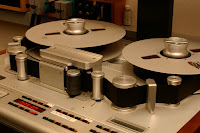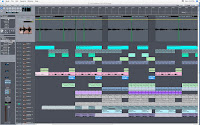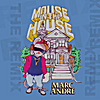Thursday afternoon (July 17th, 2010), Crystal and I arrived at our hotel in Brentwood, TN around 4:00pm. We had made surprisingly great time and had encountered very little traffic. It seemed quite unreal that in less than 24 hours, we’d be tracking at Dark Horse Recording about a half hour away in Nashville. The last time I had recorded at Dark Horse was in October of 2003. It felt like a dream to be back at it again.
‘Twas The Night Before Tracking…We chilled out in our hotel for a little while, and then headed down to the local O’Charley’s for a bite to eat. I had a turkey burger with salad and sweet potato fries, and Crystal had cheesy potato soup and shrimp salad. Good stuff! After filling our bellies, we traveled north to Dark Horse to drop off the Pro Tools files that needed to be imported for the morning recording session. Unfortunately, our mapquest directions were quite inaccurate so we had to call co-producer Dave Bechtel for help. It took us a little while to find our way, but we eventually arrived at Dark Horse at around 8:00pm. We stepped out of the car into the still yet muggy Nashville night air and headed in to The Lodge (the largest room in Dark Horse) where we met co-producer Dave Bechtel and studio assistant Mike Carr. This is the first time I had ever met Mike, a bearded and friendly heavy rock bassist who shook my hand, and after a moment of awkward silence exclaimed, “So I hear you brought a hard drive?” “Why yes!” I said. I pulled my new firewire 500 gig hard drive out of its shiny black pouch, and handed it to Dave who took it to a back room and plugged it into Dark Horse’s Mac which sported the latest version of Pro Tools HD. After the drive was plugged in, Mike opened the very first Pro Tools session (for track #1) only to be met by an unwelcoming screen with a white box that read “DAE Error.” The air pulsed with tension as Dave and Mike scratched their heads. Fortunately, I had brought a back up drive as well as a stack of DVDs that contained copies of the Pro Tools sessions. Nevertheless, I was a bit concerned as this whole trip could be a loss if those Pro Tools sessions failed to open. After several minutes of discussion, Dave and Mike concluded that my firewire 800 drive must not be compatible with Pro Tools HD (Pro Tools LE seems to work fine with firewire 800, but apparently Pro Tools HD prefers the firewire 400 protocol). The solution was simple – copy all of my files onto one of Dark Horse’s hard drives. Dave, Mike, Crystal and I chatted for a good twenty minutes as the files copied, and after the files were transferred, Mike opened each Pro Tools session to ensure that everything was playing back correctly. I think we ended up leaving Dark Horse around 9:30pm.
Let The Recording Begin!


Crystal and I awoke around 8:00am Friday morning unexpectedly rested. I had figured I wouldn’t sleep with all the excitement of the big day, but I surprisingly passed out Thursday night. After getting ready, we sampled our hotel “continental” breakfast (which was rather lame with fruit loops, muffins, strange sausage, and egg beaters), packed the car, and stopped at Starbucks for an am pick-me-up. We arrived at the studio around 9:00am. Guitarist Matt Meyer (our friend from Hilliard, OH) had arrived about an hour before us, had set up his amp and pedals, and was practicing through his notebook of song charts. Drummer Miles McPherson was in the other room setting up his drum set. I took a moment to say hi to Miles and then sat down on one of the leather couches and began reviewing my recording notes. Crystal contently sipped her coffee in a big leather chair to my left.




Dave and Mike skipped from one room to the next, adjusting microphones and sound deadening material. Dustin, one of the interns, entered the room with a large stack of unnecessary chart copies (as I had brought 5 tabbed and colored-coded notebooks - one for each person involved). Bassist Joeie Canaday stepped into The Lodge around 9:45 and greeted me with a smile. Not long after this, Dave began setting recording levels starting with Mile’s kick drum. We began rolling as planned just around 10:01 am. With the first two bars of the first song, I knew this was going to be a great day.
You Know You’re a Professional When…


The goal was to track drums, bass, and electric rhythm guitar for twelve songs in six hours. We had a lot to accomplish. Basically, we had just about thirty minutes allotted for each tune (This was similar to our
Backstage Pass recording session in 2003, although that session included two guitarists - Mark Baldwin and Jerry McPherson (drummer Mile’s McPherson dad), pianist Rich Barrett, and the Nashville String Machine orchestra). The first four songs went relatively smoothly although by noon, we were about 45 minutes behind the predicted schedule. The players nailed most of the songs in one take (with a punch in or two), yet additional time was required as Miles and Joeie had to re-write each of my number charts. Here is the typical order of events. First, studio assistant Mike would play back a song’s MIDI demo 1-2 times as Miles and Joeie stood at a table in the control room and feverishly transcribed their own simplified versions of my number charts. Moments later, Miles would grab his bottle of orange juice and slip into the drum room with a quirky comment and an energetic “Let’s do this!” (I think he must have drunk about four bottles of orange juice that Friday).
I still can’t believe the talent of these guys. I don’t think Miles or Joeie had listened to any of the demos, yet they played each song nearly perfectly in a single take. It was so amazing to hear the songs come to life! You can do a lot with MIDI these days, but there is nothing like a real drummer, bassist, and guitarist.
Tacos, Tours, and Technical DifficultiesWe broke for lunch around 1:15pm. We had tracked six songs, and had six to go. One of the interns had made a run to Franklin’s Oscar’s Taco Shop and had returned with food for the band. Crystal, Matt, Dave, and I sat in Dark Horse’s dining area and chatted with Miles and Joeie about touring, recording, and music (Miles will soon be going on the road with Kelly Clarkson and Joeie will be touring with LeAnne Rimes). For dessert, Crystal shared a batch of her homemade chocolate chip peanut butter cookies – a definite hit.

Everyone trickled back into the studio, and after the last cookie was devoured, the recording re-insued around 1:45. We were still about forty-five minutes behind, but made up for lost time after lunch (despite the taco comas). The guys navigated the remaining six songs with ease, and hit the last note of the 12th song a little before 4:00pm (there is a 13th song on the album, but it is a piano/strings/vocal only song and will be recorded at a later date). While Miles and Joeie were packing up their instruments, studio assistant Mike Carr made copies of all the Pro Tools sessions as the recorded files had inadvertently ended up on multiple drives (a very bad thing). Basically, making a copy of a Pro Tools session consolidates all the media to one location (which in this case happened to be Dave’s personal drive as my drive did not play well with Pro Tools HD). It’s really important that all the files are in one location. Otherwise, it’s easy to loose/misplace valuable data.
Guitar Overdubs and File TransfersIn the meantime, Matt, Crystal, and I helped Miles carry his drum set pieces out to his SUV. He was on his way to pick up a birthday present for his wife, which was the next day. It was entertaining to watch Miles and Joeie shake, hug and say their farewells. I think they had a lot of fun. What great guys.

After all the Pro Tools files were copied, Dave and I spent a couple hours recording additional electric guitar parts with Matt Meyer. Our purpose for this day was to simply capture rhythm electric guitar, which means much of what we recorded were power chords and arpeggios (lead parts will be done at a later date, and acoustic guitar will be recorded here in Columbus at 10x12 Productions). Matt has done such a great job so far and I’m so thankful that he can be a part of this project! Thanks Matt!
We finished recording around 7:00pm. The final step was to copy all the files onto my personal drive. Dave would be keeping a copy and I would be keeping a copy. The total data count was about 32 gigs of 24-bit 48kHz audio (each song took up about 2-3 gigs).

The day had been a success! To celebrate, Dave, Matt, Crystal and I journeyed to downtown Nashville for a mouth-watering pizza at the Mellow Mushroom. We chatted about recording, the World Cup, and reminisced on what had turned out to be an unbelievable session. Crystal and I arrived back at our hotel around 11:00pm. This time, I found it difficult to sleep. I was still ramped up about the day, and felt that I should back up all the data to a second drive. I also began opening the Pro Tools sessions to ensure that everything was there and playing properly. I think we finally fell asleep about 1:30am.
The next day, I finished checking the Pro Tools sessions and discovered that one song was missing some guitar files! Fortunately, they were still on one of Dark Horse’s hard drives, and Dave was able to post the files on his site for me to download.
I returned to Columbus a happy camper. Thanks again to everyone who prayed for us! I’m looking forward to sharing this new music with you.
To hear some humorous audio out takes from our Dark Horse session, click here.
 Here are some things I’ve accomplished over the last few weeks.
Here are some things I’ve accomplished over the last few weeks.








































